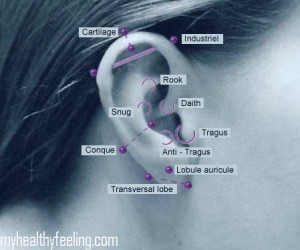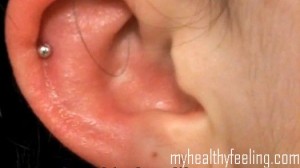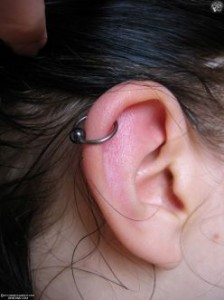Ear cartilage piercing is an exotic body art done on either one of both the ears. This is an ancient practice known through various evidences indication historical culture. It is conventionally known as ear piercing which was usually done at the ear lobe. However, through the course of time the practice evolved and is now done anywhere suitable on ear. The piercing creates small hole in the cartilage or earlobe which helps the person to wear earring or other adornments. There are numerous options in regards to location of piercing, angles, adornment option etc. This enhances one’s look as per their desire.
While piercing it is essential to remember that you need to take care of the perforated area. The area is sensitive and regeneration of the cartilage is very slow, which makes it essential to take appropriate care. Most people do not know to take care of the pierced ear cartilage to heal it faster. It is believed that it takes approximately 3 to 12 months for the ear cartilage piercing to get cured. However, it may get cured within a month as well. To avoid infection at the perforated region you should not touch it with unwashed hands neither allow anyone else to touch it.
Different Types of ear cartilage piercing:
• Antitragus ear piercing done at the lateral, inferior of the extrusive cartilage
• Conch ear piercing is also referred to as shell piercing which is done at the funnel interior to the Antihelix or Antihelical fold.
• Daith ear piercing is usually done at concha or conchae.
• Helix ear piercing is done at the top part of ear helix. This is perhaps the most common kind of ear piercing. Helix ear piercing may be very irritating and painful while sleeping, during initial few weeks, as it heals through the course of time, it may turn normal.
• Rook ear piercing is done at triangular fossa or antihelix region of the ear. Rook is a vertical kind of piercing. It can be done individually or is usually accompanied by snug piercing.
• Snug ear cartilage piercing can be done individually but is usually done along with Rook piercing. While rook piercing is a vertical piercing, snug piercing is horizontal piercing done at anti helix. Sometimes it may become difficult to have rook as well as snug piercing due to deformed ears.
• Tragus ear piercing is another preferred ear piercing style. A hole is made at the tragus where bar bells, rings, bead rings or other adornments can be worn. This kind of piercing can take approx 3 to 6 months. It may make it difficult to itch or clean your ears when suddenly required.
• Vertical lobe piercing is done at the cartilage in vertical direction from upper internal region of the lobe and not exactly at lobule but inside the helix cauda.
The aforementioned are some types of ear cartilage piercing, which may seem easy to hear but it is difficult to undergo and take care of, one should ensure hygiene and cleanliness of the pierced region. Here are some tips to take care of the perforated region and cure it faster.
• You should clean your ear pierced area at least once a day using antibacterial detersive, but avoid washing too frequently; once a day is enough.
• Avoid using alcohol swab, oil from tea tree or hydrogen peroxide for wiping clean your pierced region
• There are chances that you may also experienced pain or fluid discharge due to infection of pierced region. You should consult your piercer or a doctor if any of such abnormality is experienced.
• Vitamin C as well as zinc is know to be beneficial for curing the puncture
• Before you change your adornment yourself, wait until the hole is completely healed
Step by step procedure for cleansing ear cartilage piercing:
Before you start cleansing ear piercing you should clean your hands with antibacterial soap. Wet the region with plain water and use small amount of antibacterial detersive to make leather on the affected region. Remove the crusted discharge using wet cotton swab, ensure to clean it away from the jewelry as well. Leave the antibacterial detersive on the piercing for sometime while moving the adornment forth and back to loosen its hold and allow the solution enter the minute hole. Rinse the detersive away using water and dry thoroughly using clean cloth.
According to some ancient beliefs it is said that applying coconut oil on the pierced region and moving the ear rig back and forth would speed up the healing process. But again you have to ensure that the area is not touched with unwashed or unhygienic hands.
When to change the jewelry:
Changing the jewelry during the healing process of the pierced ear, may damage the region; this may also slow down the healing. Hence, allow the perforated region to cure completely before you change your ear adornment. You will be able to determine easily whether the piercing is cured, by rotating or moving the ear ring back and forth. If it easily happens without irritation then it is healed and you can change your adornment then.
Infection of ear cartilage piercing:
Infection of ear cartilage piercing can be irritating and may make the healing process very slow. Such conditions show symptoms like increased pain or irritation of the pierced area, foul fluid discharge, redness of perforated region and sometimes swelling. If such a condition is noticed at the punctured region, ensure to consult your doctor and seek treatment. The issue is usually benign and cures without too many issues.
Prevent bacterial infection on ear cartilage piercing:
Bacterial infection may make things worse with your pierced ear cartilage, therefore disinfect the region regularly. Here are some tips to avoid bacteria from infecting your ears.
• Avoid direct contact with telephone handset or mobile phone, as it may carry bacteria
• Ensure any hearing aid is not directly touched to the piercing
• Avoid cleaning your ear for sometime till the perforated region is cured
• Do not touch the region with your fingers
• Make sure pillow case is washed and clean
Ensure to follow these tips as, these are few important measures that may help you in preventing bacterial infection from affecting you ear cartilage piercing.



GRILLZ SALE – https://www.msmjewelers.com/collections/pendants-necklaces-for-men | MSM Jewelers has Grillz at low prices! Visit MSM Jewelers at https://www.msmjewelers.com/collections/pendants-necklaces-for-men to save big on fashionable jewelry! #Jewelry #Grillz